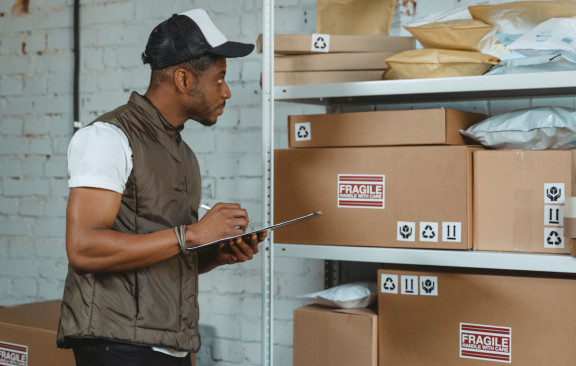Most consumers have very little idea (or concern) about how the clothes they buy or the appliances they have delivered actually get to them. As far as they are concerned, these items are available so they buy them. What does matter to consumers is that their purchases get to them in one piece, as advertised. But that's only the very end of the story.
The story begins at the start of what is known as a supply chain. We talked some about the concept of supply chains last week, but today we'll be going a little bit deeper into the definition, and its specific applications for dropshippers.
Supply chain definition
Investopedia defines a supply chain as a “network of different companies” that is directly involved in bringing end products to the consumer.
This typically starts with companies that produce raw materials. For example let's say a company collects cotton; it would then process it (i.e., spin it into fabric) and hand it off to a textile company. These textile companies are the ones that supply clothing manufacturers, who in turn produce clothing. The clothes are then finally sent to wholesalers and distributors to supply retailers and independent sellers.

Without a supply chain, consumers would have to go to each company and get the goods they need as they need them, or else they'd be forced to make products themselves. It'd be a little like growing your own rubber tree to get tires for your car.
The supply chain involves diverse mechanics that need to come together for the smooth, efficient production and delivery of goods. The supply chain process is a much bigger one than that of logistics, which is essentially just the distribution end of the process.
The bottom line... Literally
All right, that's all well and good. We now know that without an effective supply chain we'd probably be paying a ridiculous price for an AA battery because it could be in a short supply, it could cost too much to produce, or there might not be any competition to drive down prices. In other words, a good supply chain is pivotal to affordability.
The problem with that is that the supply chain doesn't only have to be efficient, it has to be relevant. It's driven by market demand, which is primarily based on consumers. If you efficiently produce a snowshoe that's affordable but it doesn't keep your feet warm, then you'll have a lot of unsold footwear laying around.
There's consequently a lot of talk up and down the supply chain about what features and functions a customer wants from a certain product. That's because consumer need is often directly affected by a company's marketing.
For example, if the shoe described above is marketed as a strength-development tool and gets a celebrity endorsement, suddenly everybody might “need” them and the price could shoot up as demand increases. (Demand works the other way, too: marketers need to adapt their messages according to what consumers want and need.) As a dropshipper, however, your main concern is how and where dropshipping fits into the picture.
Dropshipping in the supply chain
The fact is, dropshipping doesn't actually fit into the supply chain.
Dropshipping has no role in the supply chain, per se. It is one of many supply chain management techniques, and it may or may not be applicable at all, depending on circumstances. Dropshipping may be more specifically characterized as a movable part of a supply chain network, where a dropshipper may be the manufacturer, wholesaler, or retailer. There is no clearly defined role for a dropshipper because it's the client-facing side of retailing, rather than a part of the supply chain.
As you well know, dropshipping is a strategy where entity A sells goods that are physically stocked with entity B on a retail basis to a consumer. The order is then is fulfilled by entity B. It's almost like door-to-door sales, but given an Internet twist.
It's the digital equivalent of a sales agency that goes door to door selling products armed with nothing more than a few samples, some brochures, and a price list.
The sales agent doesn't need to have the item in stock. When someone makes a purchase, the order is forwarded to a manufacturer or wholesaler. The manufacturer or wholesaler delivers the order to the customer. In essence, dropshipping is a sales service, and profits come from the difference between the manufacturer/wholesaler price and the retail price.
Out with the old, In with the new?
Under a traditional supply chain, where the goods were sold to consumers through a brick-and-mortar (BAM) establishment, customers would physically go to choose and buy their items. At one point, catalogs became popular, and then customers could order their products by phone or mail. In some instances, these mail-order catalogs were handled by a third party that wasn't in the supply chain; these were the first dropshippers. (Think IKEA, which got its start as a dropshipper.)
Now that e-commerce has taken off and shoppers prefer the convenience of online retailers, dropshipping has undergone a complete renaissance as a supply chain management strategy. It allows manufacturers and wholesalers to benefit from risk pooling (that's where they don't have to worry so much about moving inventory since they have dropshippers to handle it for them). It also allows virtually anyone to go into the retail business with little or no capital and without having to manage inventory.
According to Forbes, BAMs are facing a real threat from dropshippers because overhead costs are so high to maintain a storefront. They're finding it hard to compete with a company of one operating out of an extra room in the family attic—which may only be working with a tablet connected to a neighbor's Wi-Fi. (We do, for the record, recommend having your own Wi-Fi, or at least your neighbor's permission.)
The reality of dropshipping
Despite all the positive signs, dropshipping isn't as simple as it sounds. There are many challenges that take the place of capital investment, variable costs, and inventory management. These include fulfillment issues, returns, and chargebacks. It also takes time to find reliable wholesalers that won't drop the ball. (We recommend the SaleHoo wholesale directory, where you can find more than 8,000 legitimate, pre-screened suppliers.)
These issues are becoming more manageable, however, as more and more manufacturers and wholesalers are realizing the advantages of the strategy and are getting on board. Prior to the advent of online dropshipping, suppliers had a limited reach with traditional retailers. There was only 13 percent penetration into the market and smaller profits.
Now that a large number of dropshippers are buying items at higher prices, wholesalers on average make 18.33 percent more money from dropshipping sales. To take advantage of these positives, wholesalers and manufacturers are making it much easier to coordinate with dropshippers, as they invest in more responsive systems to accommodate these growing needs.
If you believe that dropshipping is something you want to get into, this is the time to do it. If you do it right, you can circumvent many of the problems associated with this supply chain management strategy and take advantage of the growing popularity of online shopping to put more money in your own bank account.
To learn more about dropshipping, check out the SaleHoo Seller Training Center. Got a question not covered there? Let us know in the comments!











